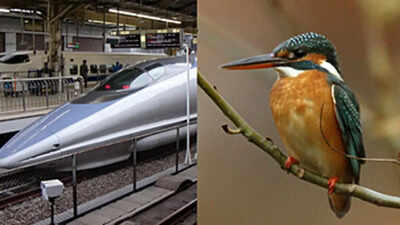Trending
Why is the bullet train’s nose shaped like a beak of a bird - here’s the real reason
Inspired by the kingfisher's beak, the bullet train's elongated nose design revolutionizes high-speed rail. This innovation mitigates sonic booms in tunnels by streamlining airflow, enhancing energy efficiency, and improving stability at high speeds. While not necessary for slower urban metros, this design is crucial for bullet trains, ensuring passenger comfort and safety through advanced aerodynamic engineering.
Though the highly anticipated bullet train is yet to roll onto Indian tracks, the buzz about it is already here. Throughout India, curiosity about this representative of technological advancement keeps increasing. While it might not have adorned Indian rail tracks yet, millions of individuals have already grown accustomed to its unique appearance through pictures and videos. The sleek silver body, often caught in motion, presents a vision of the future—where trains can reach speeds approaching 300 kilometres per hour, significantly cutting travel time and redefining long-distance travel.
As India enters the age of rail travel, it is already starting to implement these aerodynamic principles. The Vande Bharat Express, a home-built and home-designed semi-high-speed train, has a nose that is decidedly more streamlined than previous Indian trains. Its design is not merely about presenting a modern look but also about embracing science. The pointed nose enhances speed, energy consumption, and stability, all expressions of the same bio-inspired engineering ethos that underpinned the bullet trains of Japan.
What makes the bullet train nose design so unique
One of the bullet train's most eye-catching features is its nose. In contrast with the blunt, flat face of urban metros such as the Delhi Metro, the bullet train's nose is remarkably stretched and tapered. In the newest Japanese ALFA-X Shinkansen version, this nose can stretch as long as 22 metres. This distinctive shape has raised people's interest and admiration, both for its visual appeal and utility. It's not merely a design choice or a futuristic affectation; the design has a very functional source based in both science and nature.
This noise wasn't due to any mechanical failure; it was a natural consequence of physics. When the train rushed into the tunnel, it behaved like a piston, compressing the air ahead of it. That squished air had to get out somewhere, and when it did, it erupted violently, sounding like a miniature explosion. With increasing anxiety over noise pollution and the resulting psychological discomfort, Japanese engineers knew they had to come up with something that solved the problem.
Inspiration behind the nose design of the bullet train
The answer came from the most unlikely of places: nature. Eiji Nakatsu, an engineer at Central Japan Railway Company, was assigned the problem. But Nakatsu wasn't solely an engineer—he was also a keen bird-watcher. He tended to go back to nature for clues and believed millions of years of evolution could provide refined solutions to intricate problems.
In one of his observations, Nakatsu observed the kingfisher, a bird famous for its impressive hunting style. The kingfisher plunges from air to water to catch fish, but it makes hardly any splash. Its beak enables it to switch between air and water without breaking the surface too much. This apparently simple yet very efficient dive led to an epiphany. Nakatsu realised that the shape of the kingfisher’s beak was perfectly designed to minimise resistance—whether moving through air or water. If such a form could reduce disruption in nature, perhaps it could do the same for a train plunging into a tunnel.
Inspired by the kingfisher's beak, Nakatsu and his team started to rethink the bullet train's nose. Instead of the usual blunt front, they proposed a long, tapered, and aerodynamic nose that copied the bird's beak. The new design revolutionized how the train engaged the air in front of it.
The outcomes were revolutionary. The new nose cut the tunnel boom substantially by permitting air to flow more smoothly and progressively around the train, instead of piling up pressure and discharging it in one massive release. It not only addressed the noise problem, but it also made the train more energy-efficient by reducing air resistance. The more streamlined shape enabled the train to travel at higher speeds using less power, and riders had a smoother, quieter ride both within and outside the tunnel. What began as an inquiring observation of a bird ultimately transformed high-speed rail design.
Functions of bullet train’s nose design
Though bullet trains gain hugely from such sophisticated aerodynamic engineering, city train networks like the Delhi Metro don't need such designs. These systems run at lower speeds and make regular stops, so they don't have the same issues with air pressure and resistance. But even in metro stations, a burst of air can be felt seconds before a train arrives on the platform. This occurs due to a similar but much reduced build-up and displacement of air, a reminder of just how slowly even these trains respond to the air around them.
The nose of the bullet train has more than one function, beyond the purpose of controlling airflow. At speeds, it also helps stabilise the train by enabling it to push through powerful winds with minimal interference. This enhances not just comfort during rides but also safety since the streamlined nose minimises the chances of the train swaying or vibrating. Moreover, during a crash, the stretched nose can serve as a sort of crumple zone, distributing some of the impact and hence safeguarding travellers. What may seem on the surface to be a stylistic flourish is, in reality, an integral component of the train's structural stability and efficiency.
Also Read | Understanding the ‘Eye of Horus’ and its role in ancient Egyptian burial practices
End of Article
Follow Us On Social Media
Visual Stories
Tired of too many ads?










